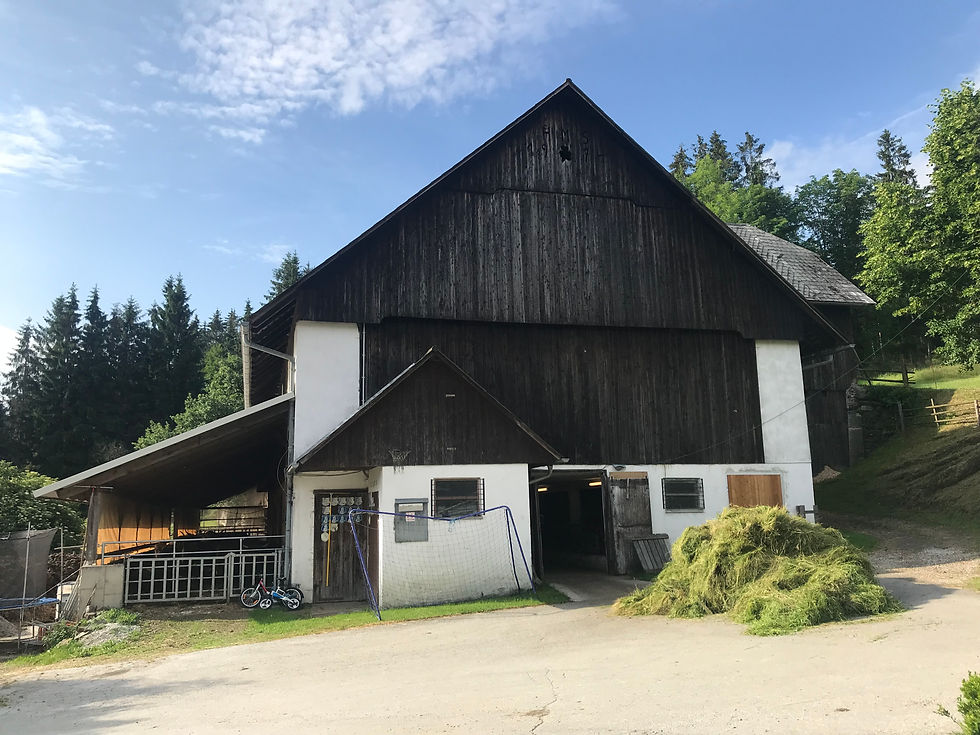Highland Beef Cattle in Styria
- Chris and Leah

- Jul 10, 2019
- 10 min read
Updated: Jul 18, 2019
Our next farm experience took us from the Western edge of the Alps to the Eastern edge in Steiermark (Styria), Austria. This is where we found Zetzzottel, a highland beef cattle operation on over 200 acres of steep pasture (well, the family considered it to be somewhat 'flat' land) and forestland. The name comes from the mountain the farm is located on, Zetz, and zottel, a German word for shaggy/long-haired making reference to the unique look of the highland cows. At this farm, we found an opportunity to work with another species of livestock and experience the traditional culture still very much present in rural Austria.

The Farm
At Zetzzottel, we lived and worked with Heli & Doris Schröck and their 3 children. The farm has been in Heli’s family for centuries (around 300 years!). They took over the farm from Heli’s father in 2008. Like most small farmers in Styria, the farm began raising Flechvieh cows for their high quality milk, which they call Styrian 'white gold.' Heli thought about his father’s experience and decided that it was time to make some changes to the family property. His main reasons for making changes to the farm were the time commitment involved with milking cows twice a day for the majority of the year, as well as the lack of control farmers have over the price of milk.

Instead, he purchased a few Highland Beef cattle with the intention of producing high-quality, grass-fed (which barely even has to be pointed out in Austria) meat for direct-to-consumer sales. This breed, originally from Scotland, was selected for their tolerance of cold temps and snowy conditions. This means that the cows can survive outdoors all year, allowing for a larger herd than could be previously contained in the dairy barn. In addition, the calves are smaller at birth compared with many breeds which results in safer births in the field and reduces the need for “pulling” calves that become stuck in the birth canal. Highland cattle are also thorough grazers, eating the grass down lower than most cattle breeds, thus making more complete use of the energy provided by the pastures.

Right now, their total herd is at about 45, including cows, calves, and some heifers. Unlike most cattle farms, they do not castrate the young males, nor do they separate them from the females. They keep a bull and the young males right along with the female cows and heifers. This eliminates the need for sorting cattle, castrating the young bulls, or dealing with any unwanted pregnancies. Instead, they believe that Bruno the bull keeps the young bulls from impregnating the females through his size and ability to sense when the cows are in heat. Even if this doesn’t always work out, they just have a cow with different genes from the father. The bull has to be replaced every 2 or 3 years anyway to avoid excessive inbreeding in the herd which can lead to health problems and the appearance of disease.
Bruno the Bull (right) is even content to snack on the lawn mower clippings. He's a nice bull.
Since all the cows are kept together, they are available to breed at any time, which results in calves being born throughout the year. Two were born while we were there, (one on Leah's birthday so it was named Leah!) and another the day before we arrived. Typically, farmers only breed their cattle at a specific time each year. Doing so makes the calving season shorter and means that most of the ready-for-market cattle can be slaughtered at the same time. In contrast, allowing year-round breeding means that there are mature, ready for slaughter animals throughout the year. This means a fresher product for customers, and one that can be bought in smaller, less expensive quantities that don’t require the purchase of a chest freezer. It also reduces the amount the farm must keep frozen (or pay others to keep frozen for them) until they are able to market the entire supply.

Usually, the farmers don’t see the newborn calves until at least 24 hours after they are born. The mother cow gives birth in the field and keeps her calf safe. Later, she moves up to the feeding barn along with the calf when it has figured out walking well enough to navigate the steep terrain. At this time, Doris and Heli start thinking about catching the calf to ear tag it for government livestock registration. The Austrian government requires every farm to register its cattle with an individual ID number. The registration is completed through an online system created by the AMA (AgrarMarkt Austria). This level of traceability is aimed at reducing farmer liability and improving consumer confidence in local meat products.

The Day-to-Day
Every morning the herd comes up to the feeding barn to eat freshly-cut grass. In addition to the mountain pastures that are always available, they are also fed ‘green chop’ or fresh-cut grass twice a day. Around 7am, our first task of the day was to evenly distribute the fresh-cut grass amongst the waiting ladies and gents in the barn. We did this a second time around 4:00 or 5:00pm, too. This flexibility was another reason the farmers prefer to raise beef cattle over dairy cows. You can load up the feeding area with grass an hour early or an hour late and the cattle can come get it when they want, rather than having to abide by a more rigid schedule that dairy cows require having to be milked every 12 hours. This allows the family flexibility to sleep a little later on Sunday or leave the farm in the afternoon without guilt or worry.

The grass is cut early every other day and then loaded into the hay wagon, all in a single pass. It is dumped in front of the barn entrance and then moved into the barn and spread out with a very handy little machine that is like a tiny tractor/fork lift/do-it-all machine. Supplemental grain (which Doris likes to call ‘Schnitzel’) is also fed on a regular basis. Water and salt licks are always available in the barn. Once all the cows are done eating, the floor of the feeding area is empty and licked clean, as if no grass had been there in the first place.
The feeding area has a slatted floor along the back wall. The manure and urine can be easily pushed back to the opening where it falls into a large underground tank. In the tank it is mixed with water and the slurry is applied to the fields as fertilizer. Just outside the feeding area of the barn is a covered ‘living room’ for the cows. This hearty breed is more likely to seek shade here in the heat of summer than they are to hide from a cold, snowy day. They used the shelter area frequently during midday, as it was an unseasonably hot June, and left plenty of manure behind to be managed.
The same day the fresh grass is cut is also the day to replace the bedding in the living room. From the second floor of the barn, spent hay from the previous year is put through an ancient machine that shreds the hay and blows it down into the living room. It is then spread out with a hayrake to cover the whole surface of the ground. The spent hay/manure combo is scooped out of the living room regularly and added to a large pile that will become a pasture amendment for late fall application.
After this was complete, care of the other livestock was the next chore of the day. The eggs are collected from the chicken coop at the same time they are fed and watered. The turkeys are also fed and watered before being let out of the barn onto a small section of pasture. The sheep have automatic waterers in their pastures, but receive supplemental grain, and occasionally the net fencing is moved to rotate their grazing.
The Pastures
All the feed for the cattle is produced on site at the farm. A combination of hay, silage, and triticale (a rye X wheat hybrid grain) are all grown on site and harvested throughout the year. Winter in the Alps can be long and snowy, so the quantity of hay and silage the cattle require for the year is high. They estimate that one large round bale is needed to feed the herd each day for the 6.5-7 months of indoor eating annually. The round bales are very compressed and weigh about 1500 pounds. The silage bales are similar in size, but last a little longer because of the higher protein content from the fermented grass.
Hay usually takes 2-3 days to dry on the field and must be turned regularly. If it rains during that time, about 40% of the feed value can be lost depending on the quantity of rain. Round bales are dried to 12-15% moisture content which is checked daily. If drying in the sun isn’t possible or they are baled a little wet to avoid impending rain, they can be dried on a rack that blows warm air through the bales.
Grass cut for silage loses about 25% of its feed value in the rain. Silage is made due to the frequent thunderstorms and humid environment. It can be baled at higher moisture content and after fermentation protein content increases. They prefer to make hay because it is cheaper (no plastic covering to buy) and think that the cows prefer it to the silage.
The grasses and legumes that make up the pasture are reseeded every two years. After each time the hay is cut, the manure from the cows is applied to the fields as a slurry. Late in the fall raw manure is spread and will break down over the winter to be available for early growth the following spring.

In addition to the extensive grass pastures, Heli also grows one large field of triticale. This becomes the grain (schnitzel) that is fed to the cattle and other livestock. It was inspiring to see a farm producing all its own feed and fertility.
The Rest
Other chores we helped out with were bread making (so much fun-thanks Doris!), fence fixing, eradicating thistles in the pasture, hay making, and helping in the vegetable garden.
The Market
This farm was a good example of a family farm successfully changing their production model while still using the same equipment, barns, and pasture lands. All their beef is marketed directly to customers through on-line sales, word-of-mouth, and posting advertisements. They offer two basic product options, but also do special orders on request. The offerings are packages of 5kg. or 10kg. of beef. Each package includes a variety of cuts-roasts, steaks, ribs, etc.

In addition to the raw beef sales, they also sell a small amount of processed product. The local diet includes daily sausage eating, so this part of the market is built-in culturally. This includes different cured beef sausages depending on their availability. The processed meats are offered to customers who are already buying the larger beef packages. The sausages are made without pickling salt, which is replaced with kombucha scoby for preservation. Pickling salt contains Sodium Nitrite (NaNO2), which is a health concern for some people. The kombucha-cured beef sausage doesn't keep as long, but tastes at least as good as the nitrite alternative. For the farmers, they have found a local health-based market niche for processed meats without pickling salt.
After Work
We spent our afternoons and weekends hiking in the nearby mountains, experiencing local events and holiday festivities with the family, visiting the alpine alms where some lucky cows live in the summer, and discovering Buschenshanks (BOO-shen-shank)- little family-owned vineyards that produce and serve their own wine, spirits, ciders, and delicious onsite picnic fare. The word literally means 'bar in the bushes' as the owners signal that they are open for business by hanging a small bush or bundle of twigs upside down over the entrance. We quickly learned that Southern Styria, appropriately called the green heart of Austria, not only has a thriving wine region, but it’s also dotted with dozens of preserved castles as the region once protected itself against many attempted invasions by the Ottoman Empire.
To celebrate our birthdays and first wedding anniversary, we went on a weekend tour of Styria, starting in the beautiful city of Graz. We enjoyed a traditional Austrian meal of pumpkin seed encrusted wiener schnitzel, potato dumplings, roasted pork in cider sauce, and organic ice cream made from red currants-a local favorite.
From Graz, we drove through Schilcherland and visited a few Buschenshanks that served impressive cured meats and spreads, cheeses, homemade breads, and surprisingly good wines made from new-to-us grape varietals, that we will never be able to get back home in the US since the wine is only sold onsite. A few of our favorite menu items were beech-smoked salami, fresh sheep cheeses, caraway bread and butter, freshly grated horseradish galore, Styrian Kaeferbohnen broad beans, and salad mixed with the region’s famous pumpkin seed oil. Apparently when Arnold Schwarzenegger (who was born near Graz) goes back to Austria for a visit, he fills his luggage with big bottles of Styrian pumpkin seed oil to take back to America . . . it’s that good.
Buschenshanks are unique eating establishments because the laws governing them were established in the 1700s by the ruling king who allowed the family owners to operate without having to pay taxes so long as they followed a specific set of rules. Firstly, the wine, cider, schnapps, and other alcoholic beverages must be made onsite using grapes, apples, berries, etc grown on the property. Don't bother trying to order beer or even coffee because neither can be legally served. Secondly, the staff must primarily be family members (some hire a few outside staff members). Often grown children are involved and specialize in a specific part of the business such as winemaking, sausage curing, etc. Usually the grandma makes the bread! Thirdly, the food must be served cold, as they are not allowed to prepare hot foods, and almost all of it is homemade, baked, smoked, cured, etc. onsite. Large and prosperous Buschenshanks can host and serve an entire tour bus full of people in 45 minutes. The last great thing about Buschenshanks is the bill. One person can eat until their belly is full and drink a couple glasses of wine for only 10 euros!
It was an exciting couple weeks! Thanks to our first Austrian family for sharing your home and life with us. It was a great experience and we will miss them and their sweet dog Zeus, who only confirmed the fact that we dearly miss our dog, Juniper.
More from Austria next time. Thanks for reading all the nerdy farm talk stuff. :)








































































Comments